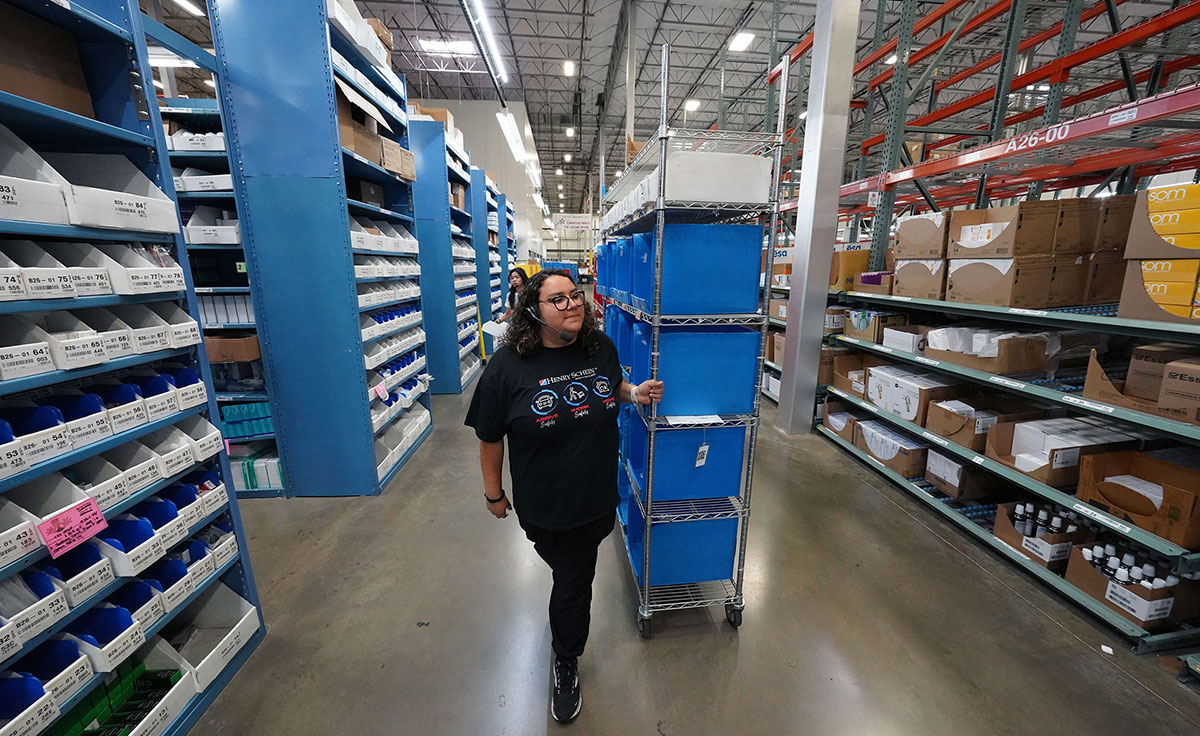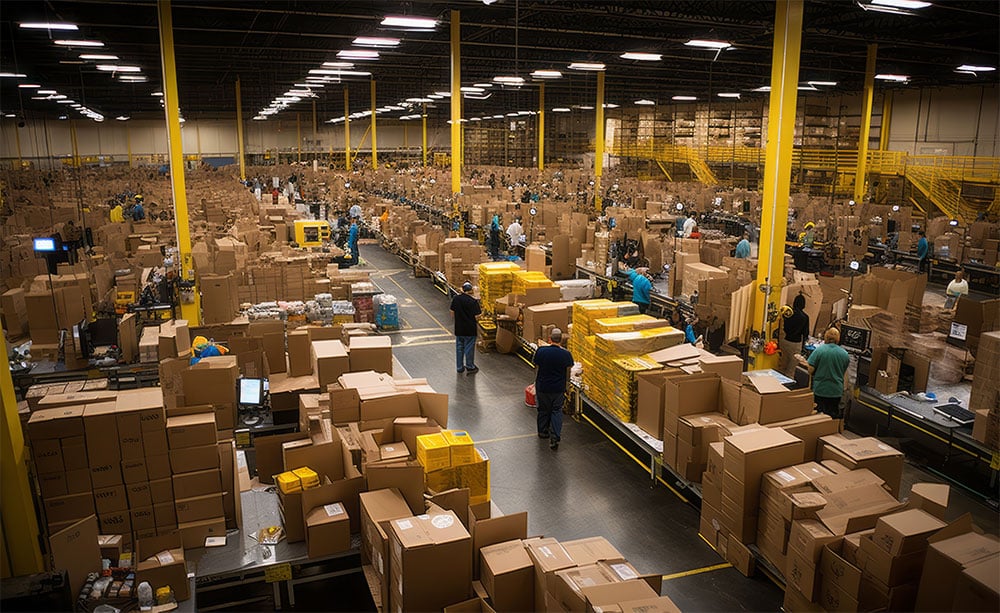By Scott Mullins, EVP of Operations and COO, Lucas Systems
Regarding warehouse execution and management systems, operators usually focus on the benefits. The top priorities are enhanced productivity, decreased worker on-floor travel, and reduced labor hours. But with those improvements inside the warehouse, your system must also provide the tools to improve efficiency downstream.
This example shows how one Lucas Systems customer in the healthcare sector realized process optimization benefits beyond the DC. This included loading time improvements, reduced transportation costs, delivery efficiencies, and on-site material handling improvements.

Warehouse Systems for Medical Supply Chain Efficiency
Lucas partnered with an integrated healthcare system in the Northeast to adopt a self-distribution strategy and contain supply chain costs. Their team knew the benefits of a voice-directed solution for improving efficiency and accuracy. They wanted a solution to do more than voice-enable their WMS-driven RF process.
Additional process changes addressed overall supply chain efficiency – within the DC and downstream. In addition to voice picking, we provided a voice-directed dock sortation process, ensuring product staging in the correct shipping cart. There were improvements within weeks of getting workers up and running with Lucas mobile applications featuring Jennifer (the brains, orchestration engine, and voice of the solution). Picking errors were cut in half, new employee training was reduced, and productivity surged, significantly lowering overtime costs.
Besides accuracy and productivity, the new system allowed the organization to consolidate orders into fewer deliveries, considerably reducing annual transportation costs. It also created more predictable, reliable deliveries, helping hospitals improve their material management processes and better organize their staffing.
A Medical Warehouse System to Improve DC Hospital Delivery
The hospital’s WMS created waves of orders for picking, determined how many totes were needed in each area, and generated shipping and delivery labels. A single hospital’s orders typically included products from every department, and some items might be required for multiple supply rooms or floors.
Before installing the Lucas solution, the WMS would release waves of work, and users throughout the warehouse would pick the orders using an RF-based picking process running on handheld mobile computers. Users would read the pick instructions on the device screens and confirm their work by scanning barcodes and key-entering information.
As noted, the WMS pre-planned the number of totes needed for each order in each area, but the process required optimization. For example, a facility might only order three items, which would be picked in three different places in three separate totes. Three totes were sent to the customer, even if those three items could fit in a single tote.
After workers picked the items in each area, they would place the completed totes and cases onto conveyors for transport to the shipping dock, where they would be sorted into one of six dock spurs based on the barcode shipping labels. Workers then manually placed the cases and totes on delivery carts and pallets based on their ship-to destination for eventual delivery to the designated hospital, nursing home, or another facility. However, the sortation process in the DC was not optimized for downstream efficiency at the hospitals.
That is because, within a single hospital, there could be hundreds of different supply areas. In the previous system, workers did not sort products within a hospital by the final delivery destination (floor or supply closet). Hospitals were receiving unsorted loads, so materials management workers would have to sort them before delivering the products to the stations on each floor.
Healthcare Supply Management Benefits and Labor Efficiencies
The Lucas solution imported orders from the WMS and optimized picking assignments based on pre-defined assignment creation rules. A process change to allow totes from one piece pick area to continue to another was implemented to create further efficiencies. This small change reduced the number of totes that needed to be shipped. The system allowed items to be picked to tote in the cart pick area and then delivered to a fast pick module while allowing other things to be added.
Instead of getting two separate totes, that customer receives one. That might not sound like a big deal, but it dramatically impacted transportation costs. Before, the DC might deliver two or three loads per night to some hospitals, but deliveries could be reduced to one and a half. That saved the organization over $150,000 in reduced fuel, and driver costs in a little over a year.
Using the Lucas warehouse management system for work assignment creation and management improved order completion and loading times. Utilizing a management dashboard, managers could get real-time updates on work status, with insight into what percent of orders were completed, across all picking zones. If one area fell behind, workers could be moved to that area to complete the shipping to meet dispatch times. This resulted in more predictable, reliable dispatch and delivery times for hospitals and other facilities, helping managers improve workforce scheduling.
Enhancing Patient Care and Healthcare Supply Chains
In addition to reducing items from multiple pick areas into a single carton, the mobile application directed the sortation process at the shipping docks in a way that ensured totes and cartons for a given delivery destination within a hospital (floor and unit) were staged on the same cart. Hospital handlers no longer needed to break down and sort incoming materials by destination.
Workers receiving items at the hospitals could get them to the floor more quickly, reducing patient wait time and material management costs at the hospitals. The solution provided real-time notification of stock-outs, helping to improve order accuracy and customer service. When pickers identified a short, managers would get notified quickly. Managers could notify replenishment workers to refill the slot so that subsequent orders would be filled.
Optimized Warehouse Management for Healthcare Providers
In healthcare distribution, operations must be focused on efficiently delivering medical supplies quickly and accurately, helping to ensure top-quality patient care at hospitals and other facilities. This includes not only processes within the warehouse but how those efficiencies and accuracy gains can be translated beyond the four walls of the warehouse into enhanced delivery, streamlined materials management at the care site, and better workforce management. Healthcare providers must ensure they get the total package across the supply chain continuum to optimize patient care delivery consistently.
 Scott Mullins is the EVP of Operations and COO at Lucas Systems, where he leads several cross-functional teams including, engineering, operations and support, with a focus on R&D, continuous improvement, scalability and new product development.
Scott Mullins is the EVP of Operations and COO at Lucas Systems, where he leads several cross-functional teams including, engineering, operations and support, with a focus on R&D, continuous improvement, scalability and new product development.
With more than 30 years in technology leadership across several supply chain and healthcare organizations in both start up and established environments, Scott has excelled in developing strategic plans for implementation and operation of client services, product development and commercialization, quality assurance and training. He has extensive technical and executive experience in software development, technical infrastructure, capacity planning, project and storage management, cloud architecture, master data management, agile methodologies, and business process improvement.
His track record of operational excellence includes serving as Chief Technology Officer at Annexus Health where he built the product and technology function for the healthcare technology start up, growing the team from 4 to 62 members. He also spearheaded the development of data-driven value-based care solutions for healthcare supply chain leader Pensiamo as Vice President of Technology and led with software development at group purchasing organization Intalere.
Scott is a graduate of the University of Pittsburgh earning a Bachelor of Science degree in Information Science.





